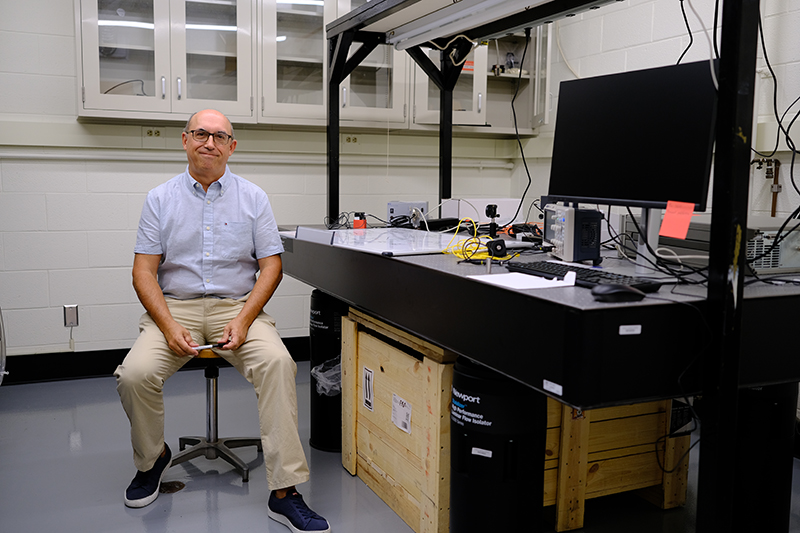Get to Know a Professor

Pablo A. Postigo is an esteemed scholar in the field of Optics, specializing in quantum photonics, laser technology, photovoltaic energy, photocatalysis, and photon bio-applications through the integration of nanotechnology and photonics (specifically, nanophotonics).
Recently joining our faculty, Professor Postigo graciously consented to discuss his life with me. He is a devoted family man, wedded to Susana Marcos, and is proud to be the father of a daughter.
Where did you grow up?
I was born in Vitoria, Spain, which is translated into Gasteiz in Basque. I got my BSc in Solid State Physics at the University of Basque Country in Bilbao in 1992. After that, I moved to CSIC in Madrid for my PhD in Physics and Electrical Engineering at the University Polytechnic of Madrid. In my thesis, I developed a new optical monitoring technique during the growth of III-V compounds by molecular beam epitaxy. From there, I moved to MIT as a Postdoctoral Fellow with Prof. Clif G. Fonstad. There I researched the integration of semiconductor lasers with high-density electronics on chips. After three years, I returned to Madrid as a primary researcher on photonic crystals, microlasers, solar cells, and quantum photonics.
How long have you been married?
Susana and I first met in Madrid while pursuing our Ph.D. studies. We married in 2000 at the University of Salamanca church, which is in Susana's hometown, and is known as one of the oldest in Europe. There, Christopher Columbus launched his plans to open a new way to India, which turned out to be America.
Where do you currently live?
We reside in Pittsford, NY, and we thoroughly enjoy it here! We appreciate the proximity to Rochester, its vibrant cultural scene featuring concerts, and numerous parks; here in Pittsford, we can conveniently stroll or bike to the Eire Canal and local farms to purchase fresh groceries like eggs and milk.
What leisure activities do you enjoy?
Outside of work, we enjoy visiting nature parks and hiking, with the Finger Lakes region offering splendid opportunities. Additionally, we share a passion for skiing!
When did you start your employment here?
I started my position at The Institute of Optics in July 2021 and have found great happiness and honor in being part of this institution. I hold my fellow faculty members and students in high regard. Currently, I am teaching the Principles of Lasers course and have developed a new curriculum titled “Introduction to Modeling in Photonics.” This curriculum covers topics such as finite difference time domain and finite domain simulations tailored for micro and nanoscale modeling in photonics. The enthusiasm shown by the students greatly facilitates the teaching experience.
What are your thoughts on teaching?
I have found teaching to be immensely enjoyable and rewarding. Each semester, I look forward to engaging with students, hearing their perspectives, and fostering meaningful discussions.
What is your focus in research?
My current research has its roots in my prior research program in Europe. It is focused on quantum photonics at room temperature. We aim to generate a single photon without the need for cryogenic refrigeration, as the current method is costly and unwieldy. Achieving this goal requires minimizing quantum decoherence, a challenge for which we apply machine learning techniques. Although our progress is promising, developing this technology is a time-consuming endeavor. In addition to quantum photonics, I am collaborating with Professor Ben Miller from the medical center on a project involving biomedical photonics and artificial intelligence (A.I.). The goal is to develop chip-scale optical biosensors capable of detecting minute molecules from the body. By harnessing machine learning and A.I., we aim to enhance the detection sensitivity of these sensors. In a related effort, we have successfully demonstrated that A.I. can rapidly design complex multilayer optical filters for far-ultraviolet applications. I firmly believe that A.I. holds immense potential for advancing various aspects of optics and photonics.
What are your goals for the next five years?
Looking ahead over the next five years, my primary objective is to bridge the gap between laboratory discoveries and practical applications by developing functional prototypes or methods. I aspire to contribute to designing or patenting prototypes that will facilitate the realization of these innovative applications.
What is your biggest obstacle?
Regarding challenges, securing adequate funding remains the most significant obstacle in my path. Transitioning my career to the United States necessitated considerable effort. I devote time to engaging with potential collaborators and investors who may help attract external interest and support for our endeavors.

